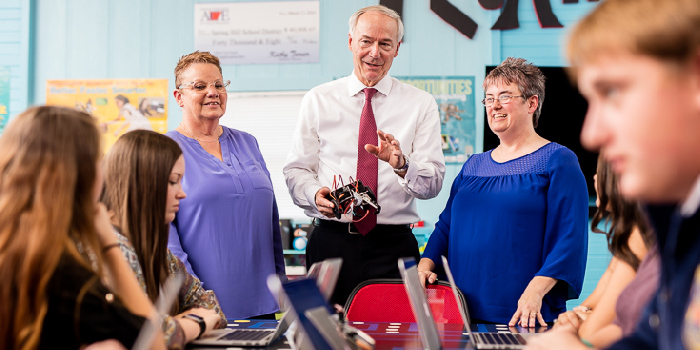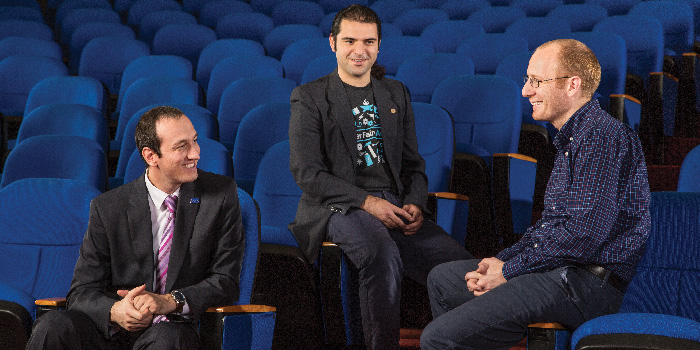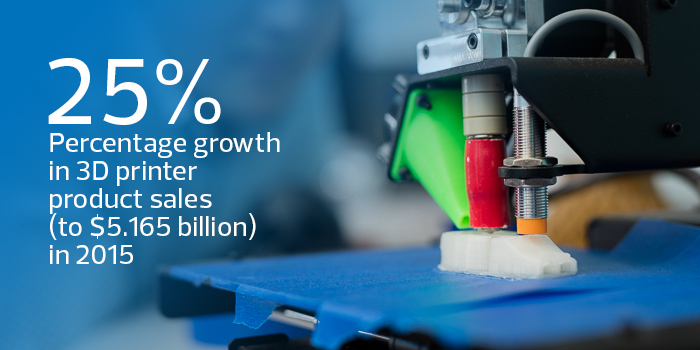Makerspaces Encourage Students to Innovate and Build Critical Thinking Skills
Two years ago, the White House hosted its first ever Maker Faire, a festival dedicated to invention, creativity and resourcefulness. Today, the spirit and sentiment behind the event — putting education into the hands of students — extends to educational environments and libraries across the country.
Spring Hill School District, a small K–12 district in southwest Arkansas, has joined the makerspace movement in a big way. The district’s massive, new makerspace was built to give teachers new ways to inspire students to hone their abilities and develop their critical thinking skills.
“All the teachers love it, and the kids love it,” says Jan Rhodes, the district’s technology coordinator for the past 25 years.
While districts like Spring Hill are implementing maker activities, there’s no single description for the makerspace movement. The best way to describe maker activities? Think about them as a means to integrate hands-on learning through experimentation, building or collaboration. That includes everything from creating cardboard robots to using 3D printers to building wearable computers.
By definition, there is no template or plan to follow. Districts implement technology of all shapes and sizes, from smartphone virtual reality viewers to electronic building blocks to notebooks and tablets.
An Evolution in K–12 Classrooms
Spring Hill School District’s makerspace evolved out of a coding initiative that started in February 2015 when Arkansas Gov. Asa Hutchinson — buoyed by his granddaughter’s knowledge of computer coding — passed into law a measure requiring every public high school in the state to offer computer science classes.
Last year, Spring Hill added a computer science class at the high school level and offered an after school coding club on the elementary level. Tammy Glass, a technology teacher who was integral to the creation of the space, wrote a grant to expand the program and was able to create the district’s makerspace. This school year, several sections of computer science have been added at the high school level. Within these classes, students utilize robotics, 3D printers and learn to code.
“We remodeled what had been a 3,400-square-foot auditorium and turned it into a makerspace this school year,” says Rhodes.

Teachers and students love the new 3,400-square-foot makerspace at Spring Hill High School which evolved out of a coding initiative from Arkansas Gov. Asa Hutchinson (center), pictured here with Technology Coordinator Jan Rhodes and teacher Tammy Glass. Photo by Dero Sanford.
The Spring Hill makerspace, which serves almost 600 children, incorporates traditional computers and laptops in addition to tablets, robotics technologies and programs such as MIT App Inventor, Sphero’s Ollie programmable robot, LittleBits electronic building blocks, a Makey Makey invention kit, Parrot’s Jumping Drones and Google Cardboard virtual reality device.
“We currently have a grant application out that will add more technology to our makerspace,” Glass says. “Right now we also have two 3D printers, a station where we take apart and put back together computers, and all the individual robots and devices where students can take them and figure out how they work.”
Spring Hill touches about 100 to 150 students daily by integrating these technologies into course offerings, ranging from high school physics and computer programming to elementary social studies, says Glass. “When kids see each other excited about something, they want to get in and do it too,” she says.
Indeed, one of the main benefits of makerspaces is motivating students, according to makerspace advocate and educator Chris O’Brien, the founder of Lower Bay Learner’s Guild, which helps New York schools create makerspaces and other project-based learning spaces.
“As a rule of thumb, project-based learning and school makerspaces work much better as tools to motivate students than any marble jar, point system, or promise of pizza ever could. One of the first comments from any teacher or guidance counselor who spends time inside a makerspace is how well student Y is understanding, focusing, or behaving on the project in front of him or her,” O’Brien wrote in a blog post last March.
A Race to Create New Spaces
Harmony Public Schools in Houston didn’t start its makerspace at the elementary level. Instead, it created makerspaces in its high schools.
Funding came as part of a four-year, $30 million Race to the Top grant awarded to the charter schools, says Burak Yilmaz, the district’s Race to the Top project director. Even the types of makerspaces within the district vary.
“In some of our schools we actually have a physical makerspace and in some we have science labs in biology, biomedical sciences, engineering — even computer science and robotics workshops that also serve as makerspaces,” he says.
Three of Harmony’s makerspaces feature a wide variety of technology, including soldering stations, 3D printers, robotics kits and laser cutters.
Makerspace resources are used in science classes such as physics, engineering and chemistry, as well as for after-school activities such as the robotics club.
“The maker education pretty much helped our teachers push the bar on personalizing the learning experience,” Yilmaz says.

Burak Yilmaz (left), Mehmet Gokcek and Yusuf Dogan from Harmony Public Schools in Texas started their makerspace mission in the high schools first. Photo by Jill Hunter.
Learning Comes First, Tech Comes Second
Lisa Brahms, director of Learning & Research at the Children’s Museum of Pittsburgh, says the technology often is secondary to the work being done. The makerspace does not need to be cookie cutter perfect, says Brahms, the project lead for the museum’s MakeShop who also runs makerspace boot camps for educators. “As long as you have people who are flexible and willing to think about it as a learning experience, anything can work.”
That is how Kimberly Connolly looks at the makerspace that she helped launch this year. Connolly, the lower school technology integrator at the Oak Knoll School of the Holy Child in Summit, N.J., says thinking comes first and technology second at her school. Above all, she wants her students to think outside the box.
“It’s a place where students can come to generate ideas, play around safely, test their ideas, feel free to fail and try again to build,” she explains. “I want my students to know that they can be inventors, but also know that not everything works on the first try.”
During the first week of school, for instance, Connolly worked with kindergarteners, creating an LED circuit. “Afterward, they took crayons and markers to generate ideas on what that light could be — fireflies, sun, car lights, flashlights and an angler fish were a few of the responses — and they drew pictures of their first idea,” she says.
The Holy Child’s K–6 makerspace has a 3D printer, a full library of littleBits electronics, Lego Mindstorms EV3 Kits and a cart of notebooks. Students have access to Chromebooks in every classroom too.
How IT Can Help Create a Makerspace
From an IT perspective, the barrier to entry is low, considering many of the elements that go into a makerspace are not networked. When IT gets involved, the results often are better than if educators try to go it alone.
“The director of technology worked with my predecessor to build up the tools and provide a stable infrastructure for me to build upon,” Connolly says. “He is 100 percent behind my idea and concepts, and has committed to helping implement this shared vision.”
IT also has to spend time thinking outside the box — just like the kids in a makerspace do, says O’Brien. They must be willing to find solutions to problems they have never encountered before as well as provide easy-to-understand directions for issues and technology in the space.
“People who are working in the professional, noneducation sector can adopt what I like to call a ‘teacher’s mind’ in order to best help the students they serve,” O’Brien says. The IT pros also have to be willing to ask tough questions about technology requests, he says, inquiring about what teachers have in mind and what they want the eventual outcome to be.
“I’ve seen people with $5,000 say, ‘Oh, let’s buy a tablet.’ And IT does it, and the teacher ends up with something that doesn’t get used,” O’Brien says. “IT has to help teachers connect technology with what they want to do, having an outcome in mind.”

SOURCE: Wohlers Report 2016: 3D Printing and Additive Manufacturing State of the Industry, April 2016. Photo by Dero Sanford.
Start with Small Plans
IT also can help districts start small and create a long-term plan that can be built over time, say experts like Brahms and O’Brien. It’s something that many schools are taking to heart. For instance, even though Spring Hill School District has its new auditorium-sized makerspace, it’s looking into other implementations to bring benefits down to every child in every school, says Rhodes, the technology coordinator.
“You can go as small as a mobile station. We’ve explored putting a mobile makerspace in our elementary schools using a cart that the teachers can then check out in parts or reserve the entire cart for the day,” says Rhodes.
Kids Develop Lifelong Skills
So far, most schools are seeing big benefits from their makerspaces,says O’Brien. “Kids are learning how to think entrepreneurially and develop skills that are going to be invaluable. It’s like training today for jobs that don’t exist yet,” he says. “Letting them work in makerspaces is the best thing we can do to teach them some of the skills that are going to help them be successful wherever they end up.”
Makerspaces are changing the way students learn today and potentially how they live and work in the future, says Harmony’s Yilmaz.
“We’ve seen that the makerspace allows students to transform ideas into reality, and it ultimately sparked student interest in science, technology, engineering and math careers,” he says. “We track what percentage of our graduates go on to STEM careers and majors. It was 19 percent back in 2011 before the makerspaces were added. Last year it was 42 percent. The national average is 17 percent.”









